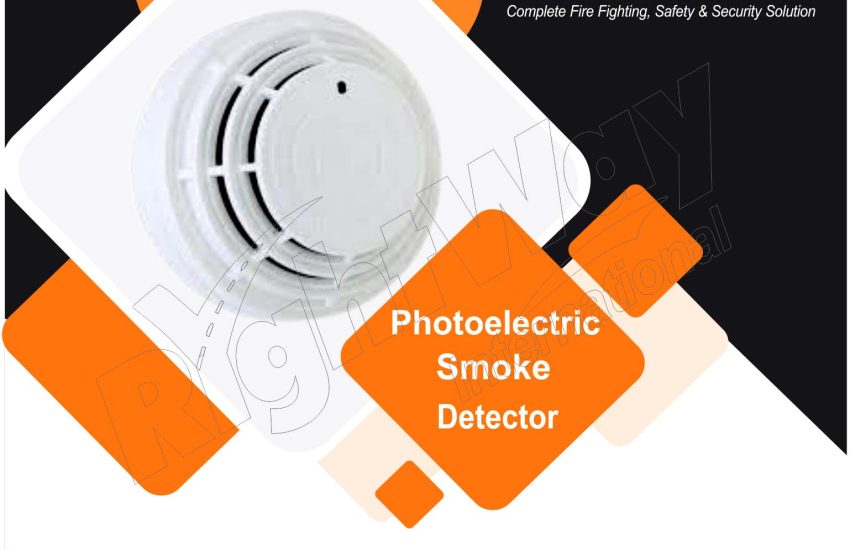Photoelectric Smoke Detectors are a key component in fire safety systems, offering a different approach to detecting smoke compared to their ionization counterparts. They are renowned for their sensitivity to smoldering fires and their ability to minimize false alarms. This article explores how work, their benefits and limitations, installation tips, and maintenance practices to ensure their effectiveness.
How Photoelectric Smoke Detectors Work
Photoelectric smoke detectors utilize light-scattering technology to detect smoke. Here’s an overview of their operation:
- Light Source and Sensor
The detector contains a light source, usually an LED, and a light sensor positioned within a sensing chamber. The light source emits a beam of light that is directed towards the sensor.
- Smoke Detection
When smoke enters the sensing chamber, it scatters the light beam emitted by the LED. This scattered light is then detected by the sensor.
- Alarm Activation
The sensor detects the increased light scattering caused by the smoke particles and sends a signal to the alarm circuitry. This triggers the alarm, alerting occupants to the presence of smoke and potential fire.
Benefits of Photoelectric Smoke Detectors
1. Effective for Smoldering Fires
These are particularly effective at detecting smoldering fires, which produce larger smoke particles. This makes them ideal for detecting fires that might not yet produce visible flames but are generating smoke.
2. Reduced False Alarms
These are less likely to trigger false alarms caused by cooking smoke or steam, as they are more sensitive to smoke particles rather than changes in air humidity or temperature. This makes them suitable for installation near kitchens and bathrooms.
3. Early Detection
The light-scattering technology used in photoelectric smoke detectors allows for early detection of smoke, potentially providing more time for occupants to evacuate in case of a fire.
Limitations of Photoelectric Smoke Detectors
1. Less Sensitive to Fast-Flaming Fires
While effective for smoldering fires, photoelectric smoke detectors may not be as responsive to fast-flaming fires that produce smaller smoke particles. This is a consideration when choosing a detector for areas where such fires are more likely.
2. Maintenance Needs
Photoelectric smoke detectors require regular cleaning to ensure their sensors remain free from dust and debris. Failure to maintain the detector can lead to reduced sensitivity or false alarms.
3. Cost
Photoelectric smoke detectors can be slightly more expensive than ionization detectors. However, their benefits in reducing false alarms and improving early smoke detection often justify the cost.
Installation Tips for Photoelectric Smoke Detectors
1. Placement
- Location: Install photoelectric smoke detectors on every level of the home, inside each bedroom, and outside sleeping areas. They should be mounted on the ceiling or high on the wall.
- Avoid Obstructions: Place detectors away from areas prone to high humidity, such as bathrooms, and avoid locations near cooking appliances to minimize false alarms.
2. Mounting
- Ceiling Installation: Mount the detectors at least 4 inches from the wall. When installing on the wall, place them 4 to 12 inches below the ceiling.
- Avoid Drafts: Ensure detectors are not located near windows, vents, or air ducts, as drafts can interfere with their operation.
3. Power Source
- Battery-Powered: Use long-life batteries and replace them annually or when the low battery warning sounds.
- Hardwired: For hardwired detectors, ensure they are properly connected to the power supply and equipped with a backup battery.
Maintenance Practices for Photoelectric Smoke Detectors
1. Regular Testing
Test smoke detectors monthly by pressing the test button. This ensures that the alarm sounds and verifies that the unit is functioning correctly.
2. Cleaning
Dust and debris can accumulate on the detector’s sensor and affect its performance. Clean the detector regularly with a vacuum cleaner or a soft brush to prevent buildup.
3. Battery Replacement
Replace the batteries in battery-powered detectors at least once a year or when the low battery alert sounds. For hardwired detectors, replace the backup battery as recommended by the manufacturer.
4. Sensor Replacement
Photoelectric smoke detectors typically have a lifespan of 8 to 10 years. Replace the entire unit when it reaches this age or if it malfunctions despite proper maintenance.
5. Professional Inspection
Have a professional inspect your smoke detectors periodically to ensure proper installation and functionality, especially in larger or more complex buildings.
Conclusion
These are a vital part of modern fire safety systems, offering effective detection of smoldering fires and reducing the likelihood of false alarms. Understanding their operation, benefits, and limitations helps in making informed decisions about their use and maintenance. Proper installation and regular upkeep ensure that photoelectric continue to provide reliable protection against fire, enhancing safety for occupants and safeguarding property. Investing in quality smoke detection technology is a crucial step in maintaining a safe and secure environment.


